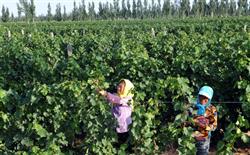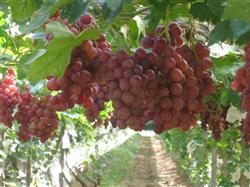Summer high temperature and drought how to prevent grape fruit shrinkage disease?

Summer high temperature drought how to prevent grape fruit shrinkage disease? Please give instructions Summer high temperature often occurs at the same time, easy to cause rapid increase in leaf transpiration, leaves not only from the root through the stem to get water, but also from the fruit to compete for water, for its transpiration. In the case of berry water loss and fruit temperature increase, local burns will occur, causing grape fruit shrinkage disease, which begins to occur approximately 30 days after fruit growth, and brown pits of needle size occur on the flesh under the epidermis of the fruit. If the pits develop rapidly, they will form disease spots. The shape of the lesion is nearly circular, elliptical or long circular, and the size varies. The diameter of the large lesion can reach 1/3 of the surface of the fruit. The spots are pale brown at the beginning, quickly blackened, sunken, like finger impressions. The disease spots have a hard feeling, the flesh vascular bundle under the disease occurs cork contraction, water loss, subcutaneous seems to have a hollow feeling, but the fruit generally does not fall off. In severe cases, several spots will occur in a fruit, nearly half of the fruit will be damaged, and growth will be suspended. Disease spots often occur in the base of fruit near the stalk or the middle and upper part of fruit surface, and the occurrence position has nothing to do with direct sunlight. They occur in the shady part under the leaf curtain, the back pudenda of the ear and the bagged ear. The disease occurs dispersedly on the ear, and the disease spots on the fruit surface are usually not concentrated and contiguous. When the disease is mild, only a small number of ears are affected, and the proportion of diseased ears will not exceed 10%. But in some years, in some varieties, especially the giant peak line varieties will be seriously infected, causing huge losses to production. Starting from the cause, improving the management of orchards and enhancing the robustness of branches and leaves are the fundamental basis for preventing this disease. Prevention and control should be carried out from the following aspects. 1. Lowering groundwater level, improving drainage conditions, deep ploughing to improve soil conditions, and increasing the activity of roots. 2. Balanced soil moisture management, especially to avoid excessive soil moisture throughout the growing season. After the rainy season, irrigation or straw covering should be done in time. 3. Strict control of nitrogen fertilizer, timely summer pruning, do not allow growth, reduce ineffective leaf area. 4. Foliar spray calcium fertilizer, commonly used calcium nitrate, calcium amino acids and so on. Calcium nitrate concentration 0.4~0.5%. Amino acid calcium contains less calcium than calcium nitrate, but the utilization rate is high, the most safe and effective. It can promote the healthy growth of grape and prevent diseases when used in the early and middle stage of hard core period. 5. Before the hard core stage, 2~3 times of application of 0. 1 ~ 0. 15% borax outside the root can also reduce the occurrence of this disease. Click for more grape growing techniques Click for more fruit growing techniques
- Prev

How to trim the grapes in summer?
How to trim the grapes in summer? Please introduce the pruning method for summer grape pruning can refer to the following methods: shoot removal is generally carried out during the period from grape sprouting to inflorescence exposure, and the earlier the shoot removal, the less nutrient consumption. The method is: sprouting buds on the trunk and old vines, and sprouts, thin and weak buds, disease and insect buds, over.
- Next

How to control diseases when planting red grape in summer?
How to control diseases when planting red grape in summer? Please introduce the prevention and control methods of grape downy mildew, white rot, anthracnose and other diseases during the high incidence period in summer, downy mildew can lead to fallen leaves, withered branches, rotten fruit and even death. Therefore, the management of Hongti vineyard should be strengthened in the rainy summer season.
Related
- Moge, come on! The staff of the peasant association in the producing area of cantaloupe were frightened when the crowd gathered.
- Causes and Solutions of low Fruit setting rate of Apple
- Symptoms and control measures of passion fruit virus disease
- Fruit growing lesson: how do apple orchards keep high yields?
- Can you build orchards in the mountains? What are the pros and cons?
- How to manage the coloring period of Crisson grape?
- This paper introduces the processing technology of two kinds of fig products.
- How much is a month for retired teachers in rural areas by 2020?
- How can strawberry planting increase sugar content? We should pay attention to management in many aspects.
- What are the cultivation techniques on how to improve the yield of golden fruit?

